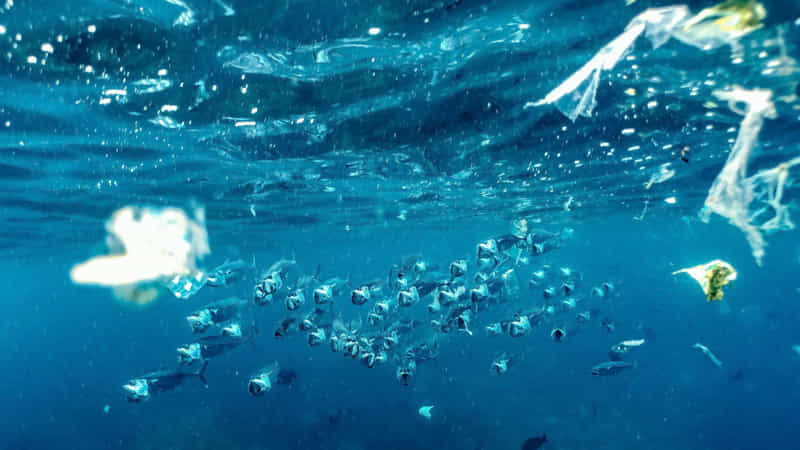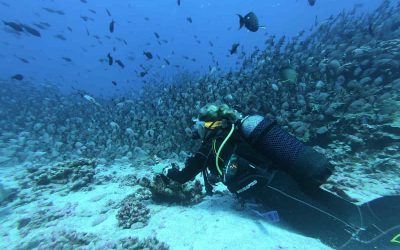We’ve known for a while that plastic waste is a serious threat to the sustainability of our planet. But in recent years, the conversation has grown louder—especially with the rise of microplastics. Because yes, microplastics are everywhere: in the sand, in fish, in the water you drink… and even in you. If you thought plastic was only a visible problem, get ready to meet its most persistent and microscopic side. This issue concerns everyone—including you, diver.
Contents
What are microplastics?
Let’s start with the basics: microplastics are plastic fragments smaller than 5 millimeters. Some are so tiny you can’t even see them—but that doesn’t make them any less harmful to the environment.
There are two main types:
- Primary microplastics: those that are manufactured small, like the microbeads in cosmetics or synthetic fibers from clothing.
- Secondary microplastics: fragments from larger plastic items that break down over time due to sun, water, or movement.
In both cases, the problem is the same: they’re incredibly difficult—or even impossible—to eliminate. They float, sink, scatter, get eaten by animals, and… continue circulating indefinitely.
The impact of microplastics on the environment and human health

This is no joke. Microplastics are one of the major global challenges humanity faces today. Their impact on the environment is devastating, and our ability to remove them efficiently is still limited. Why? Because they’re nearly invisible and globally widespread.
In the environment:
- They’re not food, but marine life often thinks they are. Fish, turtles, whales… many fall into the trap. The consequences are obvious: digestive issues, malnutrition, or even mass deaths.
- The entire food chain is affected. What the small fish eats, the big fish inherits. And if you eat the big fish… well, you know how that ends.
- They pollute from the surface to the depths. Whether you’re diving in the Caribbean or the Arctic, microplastics are there, floating and waiting.
In human health:
Although long-term effects are still being studied, microplastics have already been found in human organs, blood, and placentas. These plastics can carry harmful chemical pollutants and interfere with hormonal and cellular processes.
How can you reduce your microplastic generation?
We’ve said it’s hard to eliminate microplastics already in the ocean. But what you can do is reduce the release of new ones—and help slow down the problem. Here are some simple ways to reduce your daily impact:
- Say goodbye to synthetic clothing—or wash it less often and use special bags that trap microfibers.
- Avoid products with exfoliating microbeads, which are still sold in many countries.
- Use reusable bottles and ditch single-use plastic ones.
- Check your hygiene products: shampoos, creams, makeup… many contain tiny plastic particles.
- Buy in bulk and bring your own containers. Your kitchen (and the planet) will thank you.
Sustainable alternatives: small choices, big impact
We’re not saying you need to change all your habits overnight—but we do encourage you to start making more sustainable choices, little by little. Every decision adds up and helps you become more aware of your environmental footprint. Here are some impactful ideas:
- Choose organic cotton or natural fiber clothing: they last longer and don’t shed plastic microfibers.
- Look for brands committed to sustainability. More and more companies now offer plastic-free and biodegradable packaging.
- Reuse, repair, reinvent: instead of throwing things away, consider how you might give them a second life.
- Learn and share: the more you know, the more you can inspire others. Believe us—the collective change starts with individual actions.

What can you do as a diver?
We’re convinced that divers can and should play an active role. At DPM Diving, we believe we don’t just train divers—we create ocean ambassadors. That’s why we place such a strong emphasis on sustainability and environmental awareness, so that every dive shows respect to the marine life we encounter.
If you love the ocean, it’s time to give back. As a diver, you have a unique role as a guardian of the sea:
- Join underwater cleanups: Many dive centers organize events to collect trash (and yes, it’s more fun than it sounds!).
- Choose eco-conscious dive centers: Like DPM Diving, centers that promote sustainable practices and avoid harming marine ecosystems.
- Educate other divers: Many people don’t realize how serious the microplastic issue is—until someone tells them. Be that person! Be an ocean ambassador and spread the word about how we can dive more responsibly.
- Report polluted areas: Some NGOs use data from divers to map heavily affected sites.
- Take an Eco Diving Program: Dive schools like DPM Diving offer specific programs on marine ecology, where you can deepen your knowledge of marine life, ecosystems, and sustainable actions to take during your dives. Check out our programs on our website.
Microplastics are a real problem—but they’re also a call to action. All is not lost. Change begins by looking beyond what floats on the surface… and understanding that, even if you can’t see the tiniest plastics, they’re there—waiting for your response.
Are you ready to dive deeper and make a difference?








0 Comments